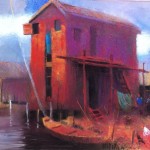I’ve written on this topic of translating your thumbnail before (click here to read an earlier post on it), but I think it’s good to repeat the idea as it does tend to be a stumbling block for many students. So what am I talking about?
You create a black, white, and grey thumbnail and doing this, you incorporate the extreme ends of the value scale – black and white – and a grey from the middle. This doesn’t mean that you need to create a pastel piece (or any painting for that matter) with a palette of extreme values.
Your thumbnail represents the areas of light, dark, and middle values in your subject. No matter how light or dark your subject (a still life full of white objects, a scene doused in darkness), it will always have some areas that are comparatively light and others that are dark. In a dark scene, there will be areas that are light compared to the dark areas. The same goes for the very light scene – there will be dark areas relative to the light areas. And your thumbnail is your way of noting those basic areas of light, middle, and dark values within the context of what you are painting.
Recently, I created a video for YouTube showing how a thumbnail translates into a high key painting. Have a look below.
(The pastel painting you see being created in this video is the same piece you saw in the blog I wrote on the benefits of using an easel.)
VIDEO
Here’s the reference I was painting from.

And the thumbnail of course! You can see there are three values – dark (very small amount), middle, and light values.

I’m going to show you a photo of the first two layers. You will see that the values read differently between the colours – the yellow is lighter than the blue.

When I add the dark value, suddenly the other two values look closer in value to each other as they stand together in stark contrast to the dark value. The thing is, the dark value is not as dark of a pastel colour as you might think! Check the pastels below to see what I mean!


Two more photos – building the layers and the final piece.


Let’s compare the final piece in black and white with the thumbnail. Can you see how I took my thumbnail and translated it into a high key painting? I didn’t need to use a super dark pastel for the hanger because the colour I used reads as dark compared to the other colours.


I hope that helps you with translating your thumbnail and seeing how a thumbnail represents, in extreme terms, the subtleties of your subject.
The painting I show here is a high key painting. To see a low key painting, check out this older post.
Do you still have any questions about translating your thumbnail? Please do leave a question or comment below. I’d also love to know if it helped with your understanding on how to use thumbnails.
And that’s it for now!
Until next time,
~Gail
PS. If you’d like to see the full length version of my demo, do join us in the IGNITE! 🔥Art-Making Membership. We reopen twice a year so CLICK HERE to join the waitlist!





























14 thoughts on “Translating Your Thumbnails – Painting From Your Black, White, and Grey Sketch”
Thoroughly enjoyed this blog and I have developed a high regard for my thumb nail S
That’s great to hear Sandy!
Gail, your instruction videos are just wonderful! I can’t wait until
the next one arrives!!! I share it with everyone I can just starting out in this great medium! Thank You for all you do!!
Gayle thank you so much for your enthusiastic response! It makes all the effort worthwhile 😁
And thank you for sharing!
Great video Gail. I’m pretty new to understanding this but I found the vid very helpful. Beautiful painting Too!
Anne I am delighted to know this video was helpful. It’s all ongoing learning!
(And thanks for the compliment 😁)
A great explanation of something that’s so easy to forget
That’s so good to hear Eddie!
Merci Gail pour tous ces conseils qui nous permettent de progresser. J’apprécie aussi les présentations de pastellistes ; cela ouvre des perspectives intéressantes et donne une multitude d’idées.
Merci Cloclo!! Je suis heureux de savoir qu’il est tout utile!
Google translation: Thank you Gail for all these tips that allow us to progress. I also appreciate the presentations of pastellists; it opens interesting perspectives and provides a multitude of ideas.
Google translation: Thank you Cloclo! I am happy to know it is all helpful!
Nice video and helpful too.
I especially like how you capture the emotions of a hanging dress…movement, hope, spontaneity…
Thanks so much Isabella! It’s wonderful to know that so much comes through in the dress…
Muchísimas gracias por la magnífica explicación paso a paso!
Saludos
Thank you so much for your lovely comment Laura!!